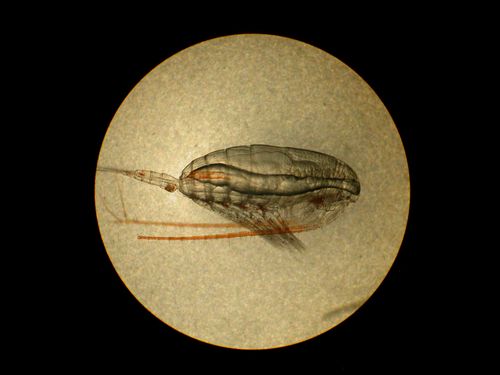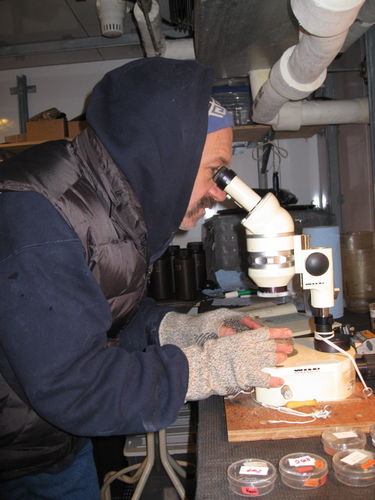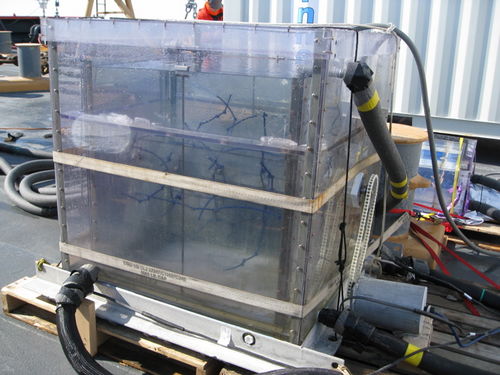Latitude: 59 54.632N Longitude: 178 06.651W
If the snow swirling around you on the slush covered bow at -30°F degrees wind chill this morning isn't enough for you... or if it is still too dark to head outside at 9am but you are craving the cold you can always pull on your parka and head on in to the cold room. Actually, you have your choice of any number of cold work-spaces in the science lab...
Take your pick...There's the two "cold rooms" where things like mud and plankton samples are kept. It's a balmy 32°F degrees freezing in there. The walk-in freezer is also an option at a mere 0°F. Then, there's the DEEP FREEZER. This place takes cold to a whole new level. Set at -81°C (or -114°F!!!), you don't want to spend much time with your hands in there. Why the need for such a cold place? Delicate samples of organic material often must be kept from breaking down in order to study it effectively. The only way to essentially halt the changing of something is to freeze it at temperatures this low. You may want to check it out but don't try to have any snowball fights in there!
Celia Gelfman and Donna Van Keuren, members of the zoo plankton team, spend a lot of their time bundled up for the outdoors- inside the cold room. I spent yesterday morning herding copepods with them. Copepods are a type of zooplankton, small animals that are like the ants of the ocean. Celia is a research assistant from the University of Rhode Island who studies them. "They're cute!", she says. They feed on the phytoplankton growing around them. At about a ¼ of an inch, (about the size of a sesame seed) you can see the shape of Calanus, a type of copepod, in the water with your "naked" eye. It is easier to take a close look at them under the microscope though. Take a look at what we saw...
 This calanus is a female copepod, a type of zooplankton. Look for her antenna that are tucked under her body! Her ovaduct, which produce eggs are where her tail attaches to her body.
This calanus is a female copepod, a type of zooplankton. Look for her antenna that are tucked under her body! Her ovaduct, which produce eggs are where her tail attaches to her body.
Capturing these little guys takes patience, steady hands and an eyedropper.
Step one: Find your victim
Step two: Identify whether or not she is a female. This can be done by looking for ovaducts- where the eggs are made.
Step three: If she is a female, the chase is on! Actually, your best chance of success is to be very, very sneaky. The Calanus sense vibrations in the water using their antenna. If you can smoothly position your eyedropper in front of them before they feel you in the water. Bingo, you can catch them on the run.
Step four: Use your eyedropper to squirt your prisoner into a large plastic cup.
Step Five: Click the counter to 001.
Step Six: Look for the next one, you have about 80 to collect.
(Hope you wore your long underwear.)
 Phil Alatalo checks to make sure that the krill he has sampled from a bottle of seawater actually made it into the dish. They're tricky litle guys!
Phil Alatalo checks to make sure that the krill he has sampled from a bottle of seawater actually made it into the dish. They're tricky litle guys!
The zooplankton team is catching these little critters to study nearly everything about their existence in the Bering Sea. They hope to learn more about their feeding and reproductive habits. They are curious about what their bodies are composed of. Genetic markers can distinguish zooplankton as part of a specific population in a specific region. In other words, by looking at a plankton's DNA, scientists can place where that plankton lived on the globe. By freezing samples of their RNA and DNA in the deep freezer, the zooplankton scientists can preserve them for studying back in their labs at home. The big question that this team hopes to find the answers to is- "How is zooplankton composition related to a changing diet and lifestyle in the Bering Sea? Phil Alatalo, of Wood Hole Oceanographic Institution, explains what brings him back to the BEST research cruise year after year. "I like looking in a part of the ocean at a certain time of the year to see what animals are there. It's like opening a newspaper and seeing what happening in the community."
While I am catching Calanus in the cold room, samples of water containing all different zooplankton are "incubating" on the bow. Just like the incubators that are testing for nutrient change over time, these incubators are helping the team to see how their zooplankton alter their environment over the course of 24 hours. What they eat and how much of it can tell a lot about an organism. On the menu for these guys is phytoplankton- and it's organic!
 The zooplankton team's incuabtor is spinning 24 hours a day. Seawater travels through the box through different hoses that must be insulated to keep from freezing. The zooplankton can be studied for change as they live in a controlled environment much like their natural habitat.
The zooplankton team's incuabtor is spinning 24 hours a day. Seawater travels through the box through different hoses that must be insulated to keep from freezing. The zooplankton can be studied for change as they live in a controlled environment much like their natural habitat.
